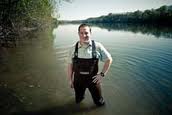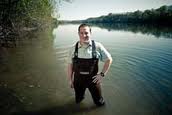Matthew E. McTammany, Ph.D.
Associate Professor, Department of Biology
Matt has an broad academic background in aquatic ecosystems, including streams, lakes, and wetlands in the Susquehanna watershed. He is passionate about the riverscape and the fundamental aquatic ecology processes in the river, beginning at the basic climate-nutrient-water chemistry level. He is a core natural scientist in the Susquehanna River Initiative and has helped shape the vision and mission of the team from its inception. In addition to overseeing the aquatic ecology research, he has created numerous new watershed-based teaching and research opportunities over the past decade. His students have gone on to the top graduate programs in the country or aquatic ecology positions in the government or private industry.
A devoted teacher and scholar who uses the river and local lakes as a teaching laboratory, Matt takes his classes on extended laboratory exercises on-the-river. He envisioned and started the water quality monitoring program, including the design and installation of the YSI sonde units at Danville (North Branch Susquehanna River) and Milton (West Branch Susquehanna RIver). He augments that data with portable water quality sondes, measuring variations in water chemistry across the river channel at selected locations throughout the year. His research is shedding light on the complexities in micro-variations in temperature and dissolved oxygen and its relation to nutrients and photosynthesis in the river. He is also shedding light on the macro invertebrate communities in the middle reaches of the watershed and how they are impacted by natural hydrobiochemical processes as well as waste treatment plants, agricultural runoff, abandoned mine discharge, natural gas development, and even pest control. These findings have tremendous importance to fisheries managers, egulatory agencies, and the public.
Matt teaches a variety of watershed-based biology courses, including aquatic ecology, limnology, and stream restoration. His students have monitored the aquatic habitat of on-campus streams as well as local streams. Matt serves as lead scientist to the Buffalo Creek Watershed Alliance, two local organizations devoted to conservation and restoration of the Susquehanna watershed.
Matt frequently presents his research at regional and national meeting of scientific and engineering organizations, including the American B, American Water Resources Association (AWRA). He collaborates with aquatic ecologists in a number of agencies including the Stroud Center, U.S. Geological Survey, U.S. Fish and Wildlife Service, and faculty at regional colleges through the Susquehanna River Heartland Coalition for Environmental Studies.
A devoted teacher and scholar who uses the river and local lakes as a teaching laboratory, Matt takes his classes on extended laboratory exercises on-the-river. He envisioned and started the water quality monitoring program, including the design and installation of the YSI sonde units at Danville (North Branch Susquehanna River) and Milton (West Branch Susquehanna RIver). He augments that data with portable water quality sondes, measuring variations in water chemistry across the river channel at selected locations throughout the year. His research is shedding light on the complexities in micro-variations in temperature and dissolved oxygen and its relation to nutrients and photosynthesis in the river. He is also shedding light on the macro invertebrate communities in the middle reaches of the watershed and how they are impacted by natural hydrobiochemical processes as well as waste treatment plants, agricultural runoff, abandoned mine discharge, natural gas development, and even pest control. These findings have tremendous importance to fisheries managers, egulatory agencies, and the public.
Matt teaches a variety of watershed-based biology courses, including aquatic ecology, limnology, and stream restoration. His students have monitored the aquatic habitat of on-campus streams as well as local streams. Matt serves as lead scientist to the Buffalo Creek Watershed Alliance, two local organizations devoted to conservation and restoration of the Susquehanna watershed.
Matt frequently presents his research at regional and national meeting of scientific and engineering organizations, including the American B, American Water Resources Association (AWRA). He collaborates with aquatic ecologists in a number of agencies including the Stroud Center, U.S. Geological Survey, U.S. Fish and Wildlife Service, and faculty at regional colleges through the Susquehanna River Heartland Coalition for Environmental Studies.
research interests
- Stream Ecology
- Human impact on aquatic ecosystems
- Restoration and management of aquatic ecosystems
- Carbon and nutrient dynamics in ecosystems
- Use of GIS and remote sensing technologies in ecological sciences
selected publications
McTAMMANY, M. E. and E. F. Benfield. In review. Role of spatial scale and stream size in determining urban impact on stream benthic macroinvertebrate communities. Hydrobiologia.
Webster, J. R., E. G. Benfield, S. W. Golladay, and M. E. McTAMMANY. In press. Recovery of particulate organic matter dynamics in a stream draining a logged watershed-a pressing situation. In W. T. Swank (editor). Ecosystem recovery from clear-cutting.
McTAMMANY, M. E. and R. H. Wynne. 2000. Spectral comparison of different age forests in the southern Appalachians. Proceedings of the American Society of Photogrammetry and Remote Sensing. CD-ROM.
Webster, J. R., J. L. Tank, J. B. Wallace, J. L. Meyer, S. L. Eggert, T. P. Ehrman, B. R. Ward, B. L. Bennett, P. F. Wagner, and M. E. McTAMMANY. 2000. Effects of litter exclusion and wood removal on phosphorus and nitrogen retention in a forest stream. Verhandlung Internationalen Vereinigung fur Theoretische und Angewandte Limnologie 27:1337-1340.
Scott, M. C., G. S. Helfman, M. E. McTAMMANY, E. F. Benfield, and P. V. Bolstad. 2002. Multiscale influences on physical and chemical stream conditions across southern Appalachian landscapes. Journal of the American Water Resources Association 38:1379-1392.
McTAMMANY, M. E., J. R. Webster, E. F. Benfield, and M. A. Neatrour. 2003. Longitudinal patterns of metabolism in a southern Appalachian river. Journal of the North American Benthological Society 22:359-370.
Webster, J. R., E. G. Benfield, S. W. Golladay, and M. E. McTAMMANY. In press. Recovery of particulate organic matter dynamics in a stream draining a logged watershed-a pressing situation. In W. T. Swank (editor). Ecosystem recovery from clear-cutting.
McTAMMANY, M. E. and R. H. Wynne. 2000. Spectral comparison of different age forests in the southern Appalachians. Proceedings of the American Society of Photogrammetry and Remote Sensing. CD-ROM.
Webster, J. R., J. L. Tank, J. B. Wallace, J. L. Meyer, S. L. Eggert, T. P. Ehrman, B. R. Ward, B. L. Bennett, P. F. Wagner, and M. E. McTAMMANY. 2000. Effects of litter exclusion and wood removal on phosphorus and nitrogen retention in a forest stream. Verhandlung Internationalen Vereinigung fur Theoretische und Angewandte Limnologie 27:1337-1340.
Scott, M. C., G. S. Helfman, M. E. McTAMMANY, E. F. Benfield, and P. V. Bolstad. 2002. Multiscale influences on physical and chemical stream conditions across southern Appalachian landscapes. Journal of the American Water Resources Association 38:1379-1392.
McTAMMANY, M. E., J. R. Webster, E. F. Benfield, and M. A. Neatrour. 2003. Longitudinal patterns of metabolism in a southern Appalachian river. Journal of the North American Benthological Society 22:359-370.
educational background
BS Biology
Bucknell University
MS Biology
Virginia Tech
PhD Biology
Virginia Tech
Bucknell University
MS Biology
Virginia Tech
PhD Biology
Virginia Tech
The Susquehanna is one of the beautiful and challenging environments I've worked in and one I see exploring for the rest of my life.
Matt McTammany


